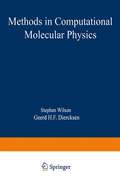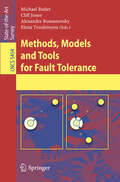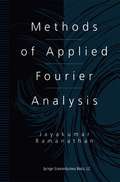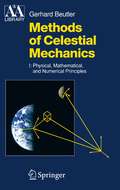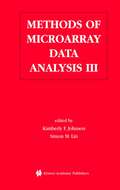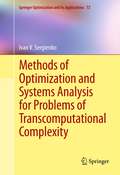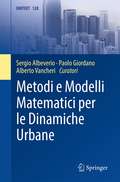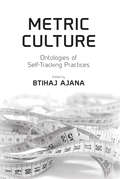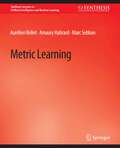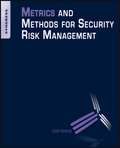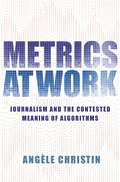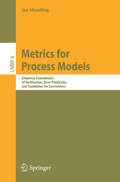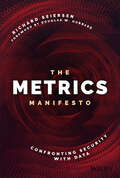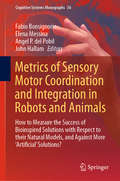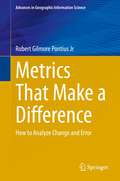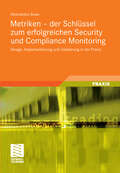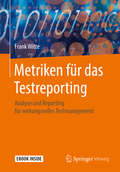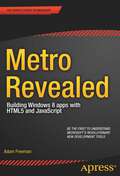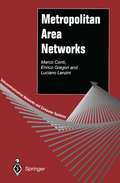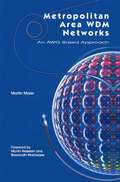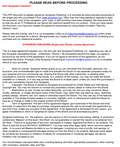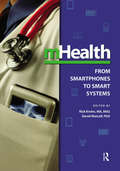- Table View
- List View
Methods in Computational Molecular Physics (Nato Science Series B: #293)
by Stephen Wilson Geerd H. F. DiercksenThis volume records the lectures given at a NATO Advanced Study Institute on Methods in Computational Molecular Physics held in Bad Windsheim, Germany, from 22nd July until 2nd. August, 1991. This NATO Advanced Study Institute sought to bridge the quite considerable gap which exist between the presentation of molecular electronic structure theory found in contemporary monographs such as, for example, McWeeny's Methods 0/ Molecular Quantum Mechanics (Academic Press, London, 1989) or Wilson's Electron correlation in moleeules (Clarendon Press, Oxford, 1984) and the realization of the sophisticated computational algorithms required for their practical application. It sought to underline the relation between the electronic structure problem and the study of nuc1ear motion. Software for performing molecular electronic structure calculations is now being applied in an increasingly wide range of fields in both the academic and the commercial sectors. Numerous applications are reported in areas as diverse as catalysis and interstellar chernistry, drug design and environmental studies, molecular biology and solid state physics. The range of applications continues to increase as scientists recognize the importance of molecular structure studies to their research activities. Recent years have seen a growing dependence of these applications on program packages, which are often not in the public domain and which may have a somewhat lirnited range of applicability dicta ted by the particular interests and prejudices of the program author.
Methods, Models and Tools for Fault Tolerance (Lecture Notes in Computer Science #5454)
by Alexander Romanovsky Elena Troubitsyna Michael Butler Cliff B. JonesThe growing complexity of modern software systems increases the di?culty of ensuring the overall dependability of software-intensive systems. Complexity of environments, in which systems operate, high dependability requirements that systems have to meet, as well as the complexity of infrastructures on which they rely make system design a true engineering challenge. Mastering system complexity requires design techniques that support clear thinking and rigorous validation and veri?cation. Formal design methods help to achieve this. Coping with complexity also requires architectures that are t- erant of faults and of unpredictable changes in environment. This issue can be addressed by fault-tolerant design techniques. Therefore, there is a clear need of methods enabling rigorous modelling and development of complex fault-tolerant systems. This bookaddressessuchacuteissues indevelopingfault-tolerantsystemsas: – Veri?cation and re?nement of fault-tolerant systems – Integrated approaches to developing fault-tolerant systems – Formal foundations for error detection, error recovery, exception and fault handling – Abstractions, styles and patterns for rigorousdevelopment of fault tolerance – Fault-tolerant software architectures – Development and application of tools supporting rigorous design of depe- able systems – Integrated platforms for developing dependable systems – Rigorous approaches to speci?cation and design of fault tolerance in novel computing systems TheeditorsofthisbookwereinvolvedintheEU(FP-6)projectRODIN(R- orous Open Development Environment for Complex Systems), which brought together researchers from the fault tolerance and formal methods communi- 1 ties. In 2007 RODIN organized the MeMoT workshop held in conjunction with the Integrated Formal Methods 2007 Conference at Oxford University.
Methods of Applied Fourier Analysis (Applied and Numerical Harmonic Analysis)
by Jayakumar RamanathanMethods of Celestial Mechanics: Volume I: Physical, Mathematical, and Numerical Principles (Astronomy and Astrophysics Library)
by Gerhard BeutlerG. Beutler's Methods of Celestial Mechanics is a coherent textbook for students as well as an excellent reference for practitioners. The first volume gives a thorough treatment of celestial mechanics and presents all the necessary mathematical details that a professional would need. The reader will appreciate the well-written chapters on numerical solution techniques for ordinary differential equations, as well as that on orbit determination. In the second volume applications to the rotation of earth and moon, to artificial earth satellites and to the planetary system are presented. The author addresses all aspects that are of importance in high-tech applications, such as the detailed gravitational fields of all planets and the earth, the oblateness of the earth, the radiation pressure and the atmospheric drag. The concluding part of this monumental treatise explains and details state-of-the-art professional and thoroughly-tested software for celestial mechanics.
Methods of Microarray Data Analysis III: Papers from CAMDA ‘02
by Simon M. Lin Kimberly F. JohnsonAs microarray technology has matured, data analysis methods have advanced as well. Methods Of Microarray Data Analysis III is the third book in this pioneering series dedicated to the existing new field of microarrays. While initial techniques focused on classification exercises (volume I of this series), and later on pattern extraction (volume II of this series), this volume focuses on data quality issues. Problems such as background noise determination, analysis of variance, and errors in data handling are highlighted. Three tutorial papers are presented to assist with a basic understanding of underlying principles in microarray data analysis, and twelve new papers are highlighted analyzing the same CAMDA'02 datasets: the Project Normal data set or the Affymetrix Latin Square data set. A comparative study of these analytical methodologies brings to light problems, solutions and new ideas. This book is an excellent reference for academic and industrial researchers who want to keep abreast of the state of art of microarray data analysis.
Methods of Optimization and Systems Analysis for Problems of Transcomputational Complexity (Springer Optimization and Its Applications #72)
by Ivan V. SergienkoThis work presents lines of investigation and scientific achievements of the Ukrainian school of optimization theory and adjacent disciplines. These include the development of approaches to mathematical theories, methodologies, methods, and application systems for the solution of applied problems in economy, finances, energy saving, agriculture, biology, genetics, environmental protection, hardware and software engineering, information protection, decision making, pattern recognition, self-adapting control of complicated objects, personnel training, etc. The methods developed include sequential analysis of variants, nondifferential optimization, stochastic optimization, discrete optimization, mathematical modeling, econometric modeling, solution of extremum problems on graphs, construction of discrete images and combinatorial recognition, etc. Some of these methods became well known in the world's mathematical community and are now known as classic methods.
Metodi e Modelli Matematici per le Dinamiche Urbane (UNITEXT #128)
by Sergio Albeverio Paolo Giordano Alberto VancheriIl testo presenta metodi e modelli per lo studio delle città viste come sistemi evolutivi che interagiscono con il territorio circostante. Gli aspetti morfologici, strutturali e dinamici sono sottolineati e analizzati con metodi qualitativi e quantitativi originati dalla matematica e dalla fisica, ma anche ispirati da altre scienze naturali e dallo studio dei sistemi socio-economici. Il libro usa la matematica in vari modi: i concetti e i metodi che vanno oltre quelli della matematica elementare vengono introdotti ed esposti brevemente, con particolare attenzione a quelli attinenti a probabilità e statistica che, non facendo parte dell'educazione di base, vengono presentati sistematicamente tramite capitoli appositi. Contributi più specializzati includono argomenti come la dinamica urbana, l'analisi di progetti architettonici per il territorio, l'uso di automi cellulari stocastici, la sintassi dello spazio urbano, l'influenza del paesaggio e della geografia, e i modelli per la mobilità urbana. Il libro è rivolto agli studenti di corsi avanzati di architettura, urbanistica e ingegneria, e a tutte le persone che studiano il territorio o vi operano.
Metric Culture: Ontologies of Self-Tracking Practices
by Edited by Btihaj AjanaWe live in a “metric culture” where data, algorithms, and numbers play an unmistakably powerful role in defining, shaping and ruling the world we inhabit. Increasingly, governments across the globe are turning towards metric technologies to find solutions for managing various social domains such as healthcare and education. While private corporations are becoming more and more interested in the collection and analysis of data and metrics for profit generation and service optimisation. What is striking about this metric culture is that not only are governments and private companies the only actors interested in using metrics and data to control and manage individuals and populations, but individuals themselves are now choosing to voluntarily quantify themselves and their lives more than ever before, happily sharing the resulting data with others and actively turning themselves into projects of (self-) governance and surveillance. Metric Culture is also not only about data and numbers alone but links to issues of power and control, to questions of value and agency, and to expressions of self and identity. This book provides a critical investigation into these issues examining what is driving the agenda of metric culture and how it is manifested in the different spheres of everyday life through self-tracking practices. Authors engage with a broad range of topics, examples, geographical contexts, and sites of analysis in order to account for the diversity and hybridity of metric culture and explore its various social, political and ethical implications.
Metric Learning (Synthesis Lectures on Artificial Intelligence and Machine Learning)
by Aurélien Muise Amaury YangSimilarity between objects plays an important role in both human cognitive processes and artificial systems for recognition and categorization. How to appropriately measure such similarities for a given task is crucial to the performance of many machine learning, pattern recognition and data mining methods. This book is devoted to metric learning, a set of techniques to automatically learn similarity and distance functions from data that has attracted a lot of interest in machine learning and related fields in the past ten years. In this book, we provide a thorough review of the metric learning literature that covers algorithms, theory and applications for both numerical and structured data. We first introduce relevant definitions and classic metric functions, as well as examples of their use in machine learning and data mining. We then review a wide range of metric learning algorithms, starting with the simple setting of linear distance and similarity learning. We show how one may scale-up these methods to very large amounts of training data. To go beyond the linear case, we discuss methods that learn nonlinear metrics or multiple linear metrics throughout the feature space, and review methods for more complex settings such as multi-task and semi-supervised learning. Although most of the existing work has focused on numerical data, we cover the literature on metric learning for structured data like strings, trees, graphs and time series. In the more technical part of the book, we present some recent statistical frameworks for analyzing the generalization performance in metric learning and derive results for some of the algorithms presented earlier. Finally, we illustrate the relevance of metric learning in real-world problems through a series of successful applications to computer vision, bioinformatics and information retrieval. Table of Contents: Introduction / Metrics / Properties of Metric Learning Algorithms / Linear Metric Learning / Nonlinear and Local Metric Learning / Metric Learning for Special Settings / Metric Learning for Structured Data / Generalization Guarantees for Metric Learning / Applications / Conclusion / Bibliography / Authors' Biographies
Metrics and Methods for Security Risk Management
by Carl YoungSecurity problems have evolved in the corporate world because of technological changes, such as using the Internet as a means of communication. With this, the creation, transmission, and storage of information may represent security problem. Metrics and Methods for Security Risk Management is of interest, especially since the 9/11 terror attacks, because it addresses the ways to manage risk security in the corporate world. The book aims to provide information about the fundamentals of security risks and the corresponding components, an analytical approach to risk assessments and mitigation, and quantitative methods to assess the risk components. In addition, it also discusses the physical models, principles, and quantitative methods needed to assess the risk components. The by-products of the methodology used include security standards, audits, risk metrics, and program frameworks. Security professionals, as well as scientists and engineers who are working on technical issues related to security problems will find this book relevant and useful. Offers an integrated approach to assessing security riskAddresses homeland security as well as IT and physical security issuesDescribes vital safeguards for ensuring true business continuity
Metrics at Work: Journalism and the Contested Meaning of Algorithms
by Angele ChristinThe starkly different ways that American and French online news companies respond to audience analytics and what this means for the future of newsWhen the news moved online, journalists suddenly learned what their audiences actually liked, through algorithmic technologies that scrutinize web traffic and activity. Has this advent of audience metrics changed journalists’ work practices and professional identities? In Metrics at Work, Angèle Christin documents the ways that journalists grapple with audience data in the form of clicks, and analyzes how new forms of clickbait journalism travel across national borders.Drawing on four years of fieldwork in web newsrooms in the United States and France, including more than one hundred interviews with journalists, Christin reveals many similarities among the media groups examined—their editorial goals, technological tools, and even office furniture. Yet she uncovers crucial and paradoxical differences in how American and French journalists understand audience analytics and how these affect the news produced in each country. American journalists routinely disregard traffic numbers and primarily rely on the opinion of their peers to define journalistic quality. Meanwhile, French journalists fixate on internet traffic and view these numbers as a sign of their resonance in the public sphere. Christin offers cultural and historical explanations for these disparities, arguing that distinct journalistic traditions structure how journalists make sense of digital measurements in the two countries.Contrary to the popular belief that analytics and algorithms are globally homogenizing forces, Metrics at Work shows that computational technologies can have surprisingly divergent ramifications for work and organizations worldwide.
Metrics at Work: Journalism and the Contested Meaning of Algorithms
by Angele ChristinThe starkly different ways that American and French online news companies respond to audience analytics and what this means for the future of newsWhen the news moved online, journalists suddenly learned what their audiences actually liked, through algorithmic technologies that scrutinize web traffic and activity. Has this advent of audience metrics changed journalists’ work practices and professional identities? In Metrics at Work, Angèle Christin documents the ways that journalists grapple with audience data in the form of clicks, and analyzes how new forms of clickbait journalism travel across national borders.Drawing on four years of fieldwork in web newsrooms in the United States and France, including more than one hundred interviews with journalists, Christin reveals many similarities among the media groups examined—their editorial goals, technological tools, and even office furniture. Yet she uncovers crucial and paradoxical differences in how American and French journalists understand audience analytics and how these affect the news produced in each country. American journalists routinely disregard traffic numbers and primarily rely on the opinion of their peers to define journalistic quality. Meanwhile, French journalists fixate on internet traffic and view these numbers as a sign of their resonance in the public sphere. Christin offers cultural and historical explanations for these disparities, arguing that distinct journalistic traditions structure how journalists make sense of digital measurements in the two countries.Contrary to the popular belief that analytics and algorithms are globally homogenizing forces, Metrics at Work shows that computational technologies can have surprisingly divergent ramifications for work and organizations worldwide.
Metrics for Process Models: Empirical Foundations of Verification, Error Prediction, and Guidelines for Correctness (Lecture Notes in Business Information Processing #6)
by Jan MendlingBusiness process modeling plays an important role in the management of business processes. As valuable design artifacts, business process models are subject to quality considerations. The absence of formal errors such as deadlocks is of paramount importance for the subsequent implementation of the process. In his book Jan Mendling develops a framework for the detection of formal errors in business process models and the prediction of error probability based on quality attributes of these models (metrics). He presents a precise description of Event-driven Process Chains (EPCs), their control-flow semantics and a suitable correctness criterion called EPC soundness.
The Metrics Manifesto: Confronting Security with Data
by Richard SeiersenSecurity professionals are trained skeptics. They poke and prod at other people’s digital creations, expecting them to fail in unexpected ways. Shouldn’t that same skeptical power be turned inward? Shouldn’t practitioners ask: “How do I know that my enterprise security capabilities work? Are they scaling, accelerating, or slowing as the business exposes more value to more people and through more channels at higher velocities?” This is the start of the modern measurement mindset—the mindset that seeks to confront security with data. The Metrics Manifesto: Confronting Security with Data delivers an examination of security metrics with R, the popular open-source programming language and software development environment for statistical computing. This insightful and up-to-date guide offers readers a practical focus on applied measurement that can prove or disprove the efficacy of information security measures taken by a firm. The book’s detailed chapters combine topics like security, predictive analytics, and R programming to present an authoritative and innovative approach to security metrics. The author and security professional examines historical and modern methods of measurement with a particular emphasis on Bayesian Data Analysis to shed light on measuring security operations. Readers will learn how processing data with R can help measure security improvements and changes as well as help technology security teams identify and fix gaps in security. The book also includes downloadable code for people who are new to the R programming language. Perfect for security engineers, risk engineers, IT security managers, CISOs, and data scientists comfortable with a bit of code, The Metrics Manifesto offers readers an invaluable collection of information to help professionals prove the efficacy of security measures within their company.
The Metrics Manifesto: Confronting Security with Data
by Richard SeiersenSecurity professionals are trained skeptics. They poke and prod at other people’s digital creations, expecting them to fail in unexpected ways. Shouldn’t that same skeptical power be turned inward? Shouldn’t practitioners ask: “How do I know that my enterprise security capabilities work? Are they scaling, accelerating, or slowing as the business exposes more value to more people and through more channels at higher velocities?” This is the start of the modern measurement mindset—the mindset that seeks to confront security with data. The Metrics Manifesto: Confronting Security with Data delivers an examination of security metrics with R, the popular open-source programming language and software development environment for statistical computing. This insightful and up-to-date guide offers readers a practical focus on applied measurement that can prove or disprove the efficacy of information security measures taken by a firm. The book’s detailed chapters combine topics like security, predictive analytics, and R programming to present an authoritative and innovative approach to security metrics. The author and security professional examines historical and modern methods of measurement with a particular emphasis on Bayesian Data Analysis to shed light on measuring security operations. Readers will learn how processing data with R can help measure security improvements and changes as well as help technology security teams identify and fix gaps in security. The book also includes downloadable code for people who are new to the R programming language. Perfect for security engineers, risk engineers, IT security managers, CISOs, and data scientists comfortable with a bit of code, The Metrics Manifesto offers readers an invaluable collection of information to help professionals prove the efficacy of security measures within their company.
Metrics of Sensory Motor Coordination and Integration in Robots and Animals: How to Measure the Success of Bioinspired Solutions with Respect to their Natural Models, and Against More ‘Artificial’ Solutions? (Cognitive Systems Monographs #36)
by Fabio Bonsignorio Elena Messina Angel P. del Pobil John HallamThis book focuses on a critical issue in the study of physical agents, whether natural or artificial: the quantitative modelling of sensory–motor coordination.Adopting a novel approach, it defines a common scientific framework for both the intelligent systems designed by engineers and those that have evolved naturally. As such it contributes to the widespread adoption of a rigorous quantitative and refutable approach in the scientific study of ‘embodied’ intelligence and cognition. More than 70 years after Norbert Wiener’s famous book Cybernetics: or Control and Communication in the Animal and the Machine (1948), robotics, AI and life sciences seem to be converging towards a common model of what we can call the ‘science of embodied intelligent/cognitive agents’. This book is interesting for an interdisciplinary community of researchers, technologists and entrepreneurs working at the frontiers of robotics and AI, neuroscience and general life and brain sciences.
Metrics That Make a Difference: How to Analyze Change and Error (Advances in Geographic Information Science)
by Robert Gilmore Pontius JrYour government warns that 10% of your neighbors have a deadly contagious virus. The producer of a diagnostic test advertises that 90% of its tests are correct for any population. The test indicates that you have the virus. This book’s author claims your test has a 50% chance of being false, given your test’s result. Who do you believe? This book gives you insights necessary to interpret metrics that make a difference in life’s decisions.This book gives methods and software that are essential to analyze change and error. Change describes a phenomenon across time points. Error compares diagnoses with the truth. Other texts give insufficient attention to these topics. This book’s novel ideas dispel popular misconceptions and replace previous methods. The author uses carefully designed graphics and high school mathematics to communicate easily with college students and advanced scientists. Applications include but are not limited to Remote Sensing, Land Change Science, and Geographic Information Science.“A wide range of tools to aid understanding of land cover and its change has been used but scientific progress has sometimes been limited through misuse and misunderstanding. Professor Pontius seeks to rectify this situation by providing a book to accompany the researcher’s toolbox. Metrics That Make a Difference addresses basic issues of relevance to a broad community in a mathematically friendly way and should greatly enhance the ability to elicit correct information. I wish this book existed while I was a grad student.” – Giles Foody, Professor of Geographical Information Science, The University of Nottingham“Metrics That Make a Difference provides a comprehensive synthesis of over two decades of work during which Dr. Pontius researched, developed, and applied these metrics. The book meticulously and successfully guides the reader through the conceptual basis, computations, and proper interpretation of the many metrics derived for different types of variables. The book is not just a mathematical treatise but includes practical guidance to good data analysis and good science. Data scientists from many fields of endeavor will benefit substantially from Dr. Pontius’ articulate review of traditionally used metrics and his presentation of the innovative and novel metrics he has developed. While reading this book, I had multiple ‘aha’ moments about metrics that I shouldn't be using and metrics that I should be using instead.” – Stephen Stehman, Distinguished Teaching Professor, State University of New York
Metriken - der Schlüssel zum erfolgreichen Security und Compliance Monitoring: Design, Implementierung und Validierung in der Praxis
by Aleksandra SowaCompliance wird oft als Verpflichtung betrachtet, die nur mit hohen Kosten umsetzbar ist. Dabei kann eine effiziente und effektive Umsetzung regulatorischer Anforderungen an die IT-Kontrollen zu einem Wettbewerbsvorteil werden, wenn der richtige Ansatz für deren Umsetzung gewählt wird. Ein solcher Ansatz - eine methodische Vorgehensweise, um durch den Einsatz von Metriken die Effektivität implementierter Kontrollen zu bewerten, Verbesserungspotential zu identifizieren und zu kommunizieren - wird in dem Buch vorgestellt. Neben einer umfassenden Sammlung von Metriken, welche direkt übernommen werden können, bietet das Buch ebenfalls die notwendige praxistaugliche Methodik zur Entwicklung weiterer eigener Metriken, Vorgehensweisen zur Aggregation von Metriken bis hin zur Informations- und Entscheidungsvorlagen für das Management sowie Beispiele für die angemessene Darstellung der Ergebnisse im Rahmen von Audit, Monitoring und Reporting.
Metriken für das Testreporting: Analyse und Reporting für wirkungsvolles Testmanagement
by Frank WitteZu jeder Softwareentwicklung gehört es dazu, das Management regelmäßig über Fortschritte und etwaige Probleme des Projekts zu informieren. Dieses Buch stellt verschiedene Testgrößen und Metriken vor, mit denen sich Fortschritte im Rahmen eines Softwaretests plastisch darstellen lassen und Handlungsbedarf leicht zu identifizieren ist. Detailreich werden dazu die für ein erfolgreiches Reporting wesentlichen Kenngrößen und Indexwerte erklärt. Ausgehend von der historischen Entwicklung des Testreportings erläutert der Autor den grundsätzlichen Nutzen der Metriken und gibt einen Überblick darüber, welche verschiedenen Arten von Metriken es gibt und wie sie im Softwaretest sinnvoll eingesetzt werden können. Er zeigt, wie sich, angefangen bei der Testspezifikation über die Testdurchführung bis hin zur Entwicklung der Testabdeckung, eine bestimmte Metrik individuell auf eine zu testende Software abstimmen lässt und wie man dadurch eine Automatisierung der Tests erreichen kann. Daneben stellt er Vorzüge und Nachteile jener Testmetriken auf, die auf Fehlern basieren, also die die Fehleranzahl, die Fehlerdichte und die Entwicklung der Fehler im Zeitverlauf messen. Mit dieser ausführlichen Auseinandersetzung mit dem Testreporting liefert der Autor eine optimale Bewertungsgrundlage, mit der sich nicht nur einschätzen lässt, welche Testmetrik man für welchen Einsatzzweck bzw. welche individuellen Projektsituation verwenden sollte, sondern auch, worin besondere Probleme einer einzelnen Metrik für das Testreporting bestehen können und wie man diese Probleme am besten löst. Damit richtet sich dieser praktische Leitfaden vor allem an Mitarbeiter in IT-Projekten, wie Projektleiter, Softwaretester und Entwickler, aber auch Unternehmens- und Technologieberater sowie Dozenten an Hochschulen und Universitäten finden hier einen spannenden Einblick in verschiedene Methoden des Softwaretestings.
Metro Revealed: Building Windows 8 Apps With Html5 And Javascript
by Adam FreemanThis 88-page primer unveils the key features of Microsoft's eagerly anticipated Windows 8 operating system. Windows 8 contains the revolutionary Metro application framework for building dynamic and responsive touch-enabled applications that target both desktops and mobile devices.With the official release of Windows 8 looming ever closer, experienced author Adam Freeman invites you to take a crash course in Metro development. Using HTML5 and JavaScript, he ensures you understand the changes that are being made to Windows development practices and puts you on the right course to creating innovative and elegant applications for this latest evolution of the world&’s most successful operating system.
Metropolitan Area Networks (Telecommunication Networks and Computer Systems)
by Marco Pellegrini Enrico Gregori Luciano LenziniWith the continuing success of Local Area Networks (IANs), there is an increasing demand to extend their capabilities towards higher data rates and wider areas. This, together with the progress in fiber-optic technology, has given rise to the so-called Metropolitan Area Networks (MANs). MANs can span much greater distances than current LAN s, and offer data rates on the order of hundreds of Megabits/sec (Mbps). The success of MANs is mainly due to the opportunity they provide to develop new networking products capable of providing high-speed commu nications between applications at competitive prices, which nonetheless give an adequate return on the manufacturers' investments. A major factor in of appropriate networking standards. achieving this goal is the availability Fiber Distributed Data Interface (FDDl) and Distributed Queue Dual Bus (DQDB) are the two standard technologies for MANs for which industrial products are already available. For this reason, this book focuses mainly on these two standards. Nowadays there are several books dealing with MANs, and these look mainly at FDDI (e.g., [2], [92], [118], [141]). These books focus primarily on the architectures and protocols, whereas they pay little attention to per formance analysis. Due to the capability of MANs to integrate services, a quantitative analysis of the Quality of Service (QoS) provided by these tech nologies is a relevant issue, and is thus covered in depth in this book.
Metropolitan Area WDM Networks: An AWG Based Approach
by Martin MaierThis extensive volume provides a comprehensive and technically detailed overview of the latest metropolitan area WDM network experimental systems, architectures and access protocols. Readers will benefit from the thorough overview and gain an in-depth understanding of current and next-generation metro WDM networks.
The Mezonic Agenda: Hack along with the heroes and villains as the American Presidency hangs in the balance of cyber-space... (Cyber-Fiction)
by Herbert ThomsonThe Mezonic Agenda deals with some of the most pressing topics in technology and computer security today including: reverse engineering, cryptography, buffer overflows, and steganography. The book tells the tale of criminal hackers attempting to compromise the results of a presidential election for their own gain. The accompanying CD contains real, working versions of all the applications described in the fictional narrative of the book. Computer users, programmers, IT professionals, and policy makers need to be made aware of the risks involved with deploying new technologies and see how attackers can leverage these technologies for their own purposes. While the story in The Mezonic Agenda is fictional, the technologies, exploits, and hacking techniques are all very real.* The first cyber-thriller" that allows the reader to "hack along" using the accompanying CD which contains working versions of all the applications described in the book. * To be published in October 2004 when interest in the American Presidential election will be at its highest. * Provides IT professionals with the most advanced, timely, and accurate information available on security exploits in a fascinating, fictional narrative.
mHealth: From Smartphones to Smart Systems (HIMSS Book Series)
by Mas, Metcalf David Rick Krohn Ma, Mas, Metcalf David Rick Kroh MamHealth: From Smartphone to Smart Systems provides a high level and comprehensive survey of the emergence of mobile technology healthcare. This book looks beyond the already-popular devices and apps associated with mHealth, exploring the major role this technology could play as healthcare steers inexorably toward an architecture
mHealth: From Smartphones to Smart Systems (HIMSS Book Series)
mHealth: From Smartphone to Smart Systems provides a high level and comprehensive survey of the emergence of mobile technology healthcare. This book looks beyond the already-popular devices and apps associated with mHealth, exploring the major role this technology could play as healthcare steers inexorably toward an architecture
